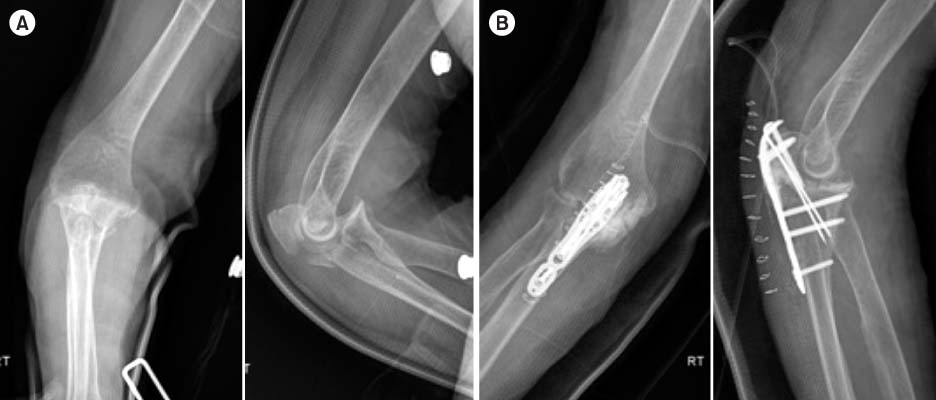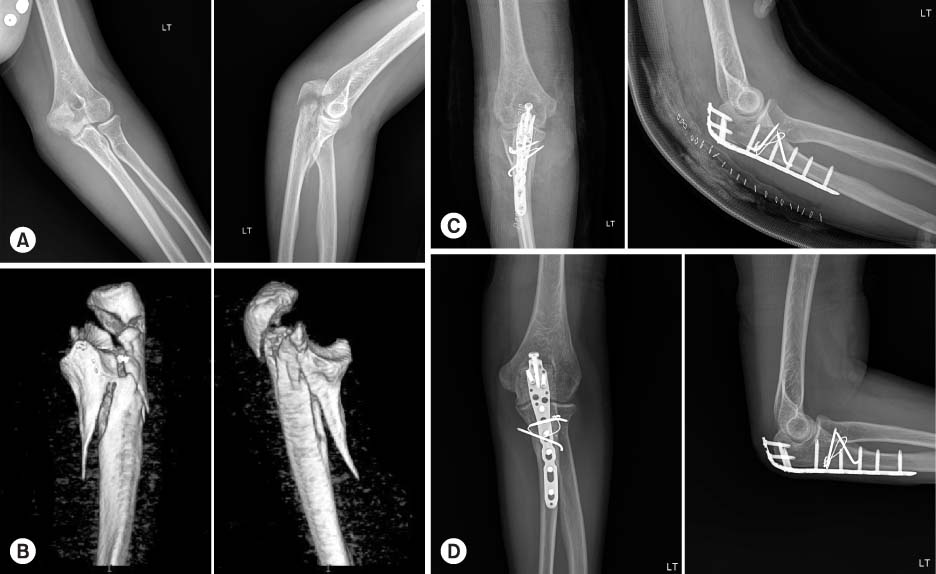Articles
- Page Path
- HOME > J Musculoskelet Trauma > Volume 28(1); 2015 > Article
-
Original Article
- Treatment of Olecranon Fractures with Proximal Ulna Comminution Using Locking Compression Plates
- Ki-Do Hong, M.D., Tae-Ho Kim, M.D., Jae-Cheon Sim, M.D., Sung-Sik Ha, M.D., Min-Chul Sung, M.D., Jong-Hyun Jeon, M.D.
-
Journal of the Korean Fracture Society 2015;28(1):59-64.
DOI: https://doi.org/10.12671/jkfs.2015.28.1.59
Published online: January 20, 2015
Department of Orthopedic Surgery, Sahmyook Medical Center, Seoul, Korea.
- Address reprint requests to: Tae-Ho Kim, M.D. Department of Orthopedic Surgery, Sahmyook Medical Center, 82 Mangu-ro, Dongdaemun-gu, Seoul 130-711, Korea. Tel: 82-2-2210-3324, Fax: 82-2-2212-2673, crash1401@naver.com
• Received: December 12, 2014 • Revised: December 24, 2014 • Accepted: December 24, 2014
Copyright © 2015 The Korean Fracture Society. All rights reserved.
This is an Open Access article distributed under the terms of the Creative Commons Attribution Non-Commercial License (http://creativecommons.org/licenses/by-nc/3.0/) which permits unrestricted non-commercial use, distribution, and reproduction in any medium, provided the original work is properly cited.
- 499 Views
- 3 Download
Abstract
-
Purpose
- The purpose of this study is to evaluate the clinical results of locking compression plate (LCP) fixation for olecranon fractures with proximal ulna comminution.
-
Materials and Methods
- We review 10 cases of olecranon fractures with proximal ulna comminution treated with LCPs from August 2011 to August 2013. Follow-up period was from 12 months to 18 months. Mean age was 63.1 years (35-84 years). According to the Mayo classification, there were eight type IIB, and two type IIIB fractures. We used Mayo classification. Clinical evaluation was performed based on radiographic union of olecranon and measurements of range of motion at last follow-up. Disability of the arm, shoulder and hand (DASH) score and Mayo elbow performance score (MEPS) were used for evaluation of functional recovery.
-
Results
- All patients had bone union. According to the MEPS, nine of ten patients had a good or excellent outcome. The mean DASH score was 18.6. All cases started postoperative range of motion (ROM) within 14 days. Elbow ROM was more than 110° in all cases except one. Mean radiological bony union time was 4.2 months (2.5-6.0 months) postoperatively. Complication was hardware irritation in three patients.
-
Conclusion
- Internal fixation using LCP for olecranon fractures with proximal ulna comminution can be a good treatment option which obtains good clinical results and enables early ROM.
- 1. Coonrad RW. The elbow. Management of olecranon fractures and nonunion. In: Morrey BF, editor. Master techniques in orthopaedic surgery. 1st ed. New York: Raven Press Ltd.; 1994. p. 71-95.
- 2. Horne JG, Tanzer TL. Olecranon fractures: a review of 100 cases. J Trauma, 1981;21:469-472.
- 3. Larsen E, Lyndrup P. Netz or Kirschner pins in the treatment of olecranon fractures? J Trauma, 1987;27:664-666.Article
- 4. Chalidis BE, Sachinis NC, Samoladas EP, Dimitriou CG, Pournaras JD. Is tension band wiring technique the gold standard for the treatment of olecranon fractures? A long term functional outcome study. J Orthop Surg Res, 2008;3:9. ArticlePDF
- 5. Lee JM, Park JH. Fractures of the olecranon of ulna treated by plating and tension band wiring technique. J Korean Soc Fract, 1996;9:801-808.Article
- 6. Cabanela ME, Morrey BF. Fractures of the proximal ulna and olecranon. In: Morrey BF, editor. The elbow and its disorders. 2nd ed. Philadelphia: WB Sauners Co; 1993. p. 405-408.
- 7. Hudak PL, Amadio PC, Bombardier C. Development of an upper extremity outcome measure: the DASH (disabilities of the arm, shoulder and hand) [corrected]. The Upper Extremity Collaborative Group (UECG). Am J Ind Med, 1996;29:602-608.Article
- 8. Daland EM. Fractures of the olecranon. J Bone Joint Surg Am, 1933;15:601-607.
- 9. Watson-Jones R. Fractures and joint injuries. 6th ed. Edinburgh: Churchill Livingstone Co; 1982. p. 650-655.
- 10. Muller ME, Allgower M, Schneider R, Willenegger H. Mannual of internal fixation. 3nd ed. Berin: Springer Verlag Co; 1991. p. 44-55. p. 460-461.
- 11. Horner SR, Sadasivan KK, Lipka JM, Saha S. Analysis of mechanical factors affecting fixation of olecranon fractures. Orthopedics, 1989;12:1469-1472.Article
- 12. Anderson ML, Larson AN, Merten SM, Steinmann SP. Congruent elbow plate fixation of olecranon fractures. J Orthop Trauma, 2007;21:386-393.Article
- 13. Simpson NS, Goodman LA, Jupiter JB. Contoured LCDC plating of the proximal ulna. Injury, 1996;27:411-417.
- 14. Hak DJ, Golladay GJ. Olecranon fractures: treatment options. J Am Acad Orthop Surg, 2000;8:266-275.Article
- 15. Macko D, Szabo RM. Complications of tension-band wiring of olecranon fractures. J Bone Joint Surg Am, 1985;67:1396-1401.Article
- 16. Scharplatz D, Allgöwer M. Fracture-dislocations of the elbow. Injury, 1975;7:143-159.Article
- 17. Bailey CS, MacDermid J, Patterson SD, King GJ. Outcome of plate fixation of olecranon fractures. J Orthop Trauma, 2001;15:542-548.Article
- 18. Kang S, Hwang CS, Chung PH, Kim YS, Chung JW, Kim JP. Double tension band wiring for olecranon fractures. J Korean Fract Soc, 2008;21:130-134.Article
- 19. Shin HD, Yang JH, Kim PS. Internal fixation using double plates for comminuted olecranon fractures. J Korean Fract Soc, 2009;22:166-171.Article
- 20. Bryan RS. Fractures about the elbow in adults. Instr Course Lect, 1981;30:200-223.
- 21. Eriksson E, Sahlin O, Sandahl U. Late results of conservative and surgical treatment of fracture of the olecranon. Acta Chir Scand, 1957;113:153-166.
REFERENCES
Fig. 1
(A) Radiographs show olecranon fracture of type IIIB with proximal ulna comminution. (B) Radiographs show internal fixation of olecranon fracture with locking compression plate postoperatively.


Fig. 2
(A) Radiographs show olecranon fracture of type IIB with proximal ulna comminution. (B) Three-dimensional reconstructed computed tomography scan shows olecranon fracture of type IIA with proximal ulna comminution. (C) Radiographs show internal fixation of olecranon fracture with locking compression plate (LCP) postoperatively. (D) Radiographs of postoperative 12 months show LCP with good congruity of the elbow.


Figure & Data
REFERENCES
Citations
Citations to this article as recorded by 

Treatment of Olecranon Fractures with Proximal Ulna Comminution Using Locking Compression Plates


Fig. 1
(A) Radiographs show olecranon fracture of type IIIB with proximal ulna comminution. (B) Radiographs show internal fixation of olecranon fracture with locking compression plate postoperatively.
Fig. 2
(A) Radiographs show olecranon fracture of type IIB with proximal ulna comminution. (B) Three-dimensional reconstructed computed tomography scan shows olecranon fracture of type IIA with proximal ulna comminution. (C) Radiographs show internal fixation of olecranon fracture with locking compression plate (LCP) postoperatively. (D) Radiographs of postoperative 12 months show LCP with good congruity of the elbow.
Fig. 1
Fig. 2
Treatment of Olecranon Fractures with Proximal Ulna Comminution Using Locking Compression Plates
Data of the Patients
ROM: Range of motion.
Table 1
Data of the Patients
ROM: Range of motion.

 E-submission
E-submission KOTA
KOTA TOTA
TOTA TOTS
TOTS

 Cite
Cite

